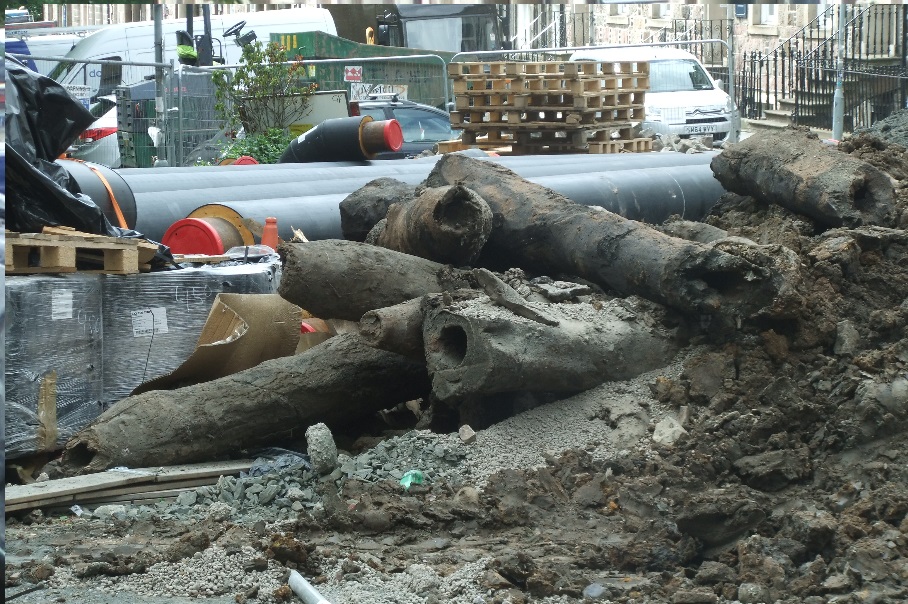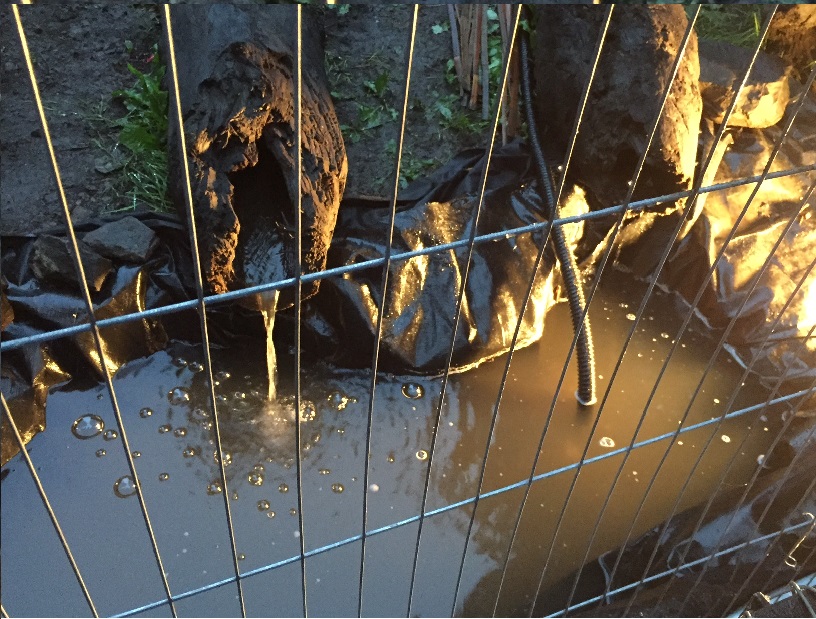The discovery of Old Wooden Water Pipes
In the summer of 2018, news came of the discovery of old wooden water pipes in George Square. They were unearthed during operations to lay a new system of pipes. This news was not hugely surprising, as such pipes had come to light in the 1980s on the west side of the Square, a couple of which were saved and stored in the City Museums' collections. The unexpected aspect of this latest find was that the pipes ran along the north side of the Square, at right angles to the path of the water supply from Comiston Springs, via the Meadows, to the reservoir on Castlehill.
The pile of pipes was spotted by Gordon Thomas of the University's Department of Archaeology, who mentioned it to a former colleague, Pat Storey. That was fortunate, because Pat recalled a lecture which I had given a few years back to the University Retired Staff Association, called 'Edinburgh's Social Conscience', which included the history of the city's water supply. I had shown an image that day of two such pipes which had been unearthed in the 19th century and which are yet displayed in Huntly House, which contains the local history Museum of Edinburgh. They formed part of my remit during my fifteen-year stint as Local Historian with the City Museums.
Upon learning of the discovery, I beetled across the Meadows next morning to the north-west corner of the Square to see the impressive pile for myself. The City Archaeologist was aware of the situation, and had instructed AOC Archaeology, a local company, to keep a lookout for anything unusual. Asking the contractors what was to become of the pipes, I was told that they were bound for landfill. This seemed a cruel fate, but there was no obvious alternative. They belonged to the City, but with the Museums Department already having several, both on display and in store, there were not the facilities to accommodate any more, and to see to their long-term conservation. I tried the National Museum of Scotland, but their Science and Technology Department also had an example, and made the same response. A couple were taken away by AOC for scientific analysis, but with no plans to retain them.
On the historical side, the first water main to serve Edinburgh was laid in 1681, and the supply was finally turned on in 1720. The pipes were originally of lead, but that material was expensive and heavy to handle, so they were replaced with ones of wood during the period 1759-79, using whole tree-trunks hollowed through their entire length. Elm was selected because of its excellent damp-repellent qualities. These pipes were gradually replaced by ones of cast-iron of a wider diameter from 1790 onwards.
Somehow, it just did not seem right that a part of Edinburgh's heritage should quite literally be thrown out with the garbage. The trouble was, even if I could save them from destruction, what could be done with them? Then an idea occurred ~ just a couple of hundred yards up the inclined section of Middle Meadow Walk, at its junction with Teviot Place, there stands the old Police Box which for the past few years has been occupied by fellow FoMBL member Fernando Miranda, functioning as a takeaway for his tasty Brazilian snacks. He also rents the plot of land adjacent, in which he has created a children's garden, and a stage for public performances. The next little plot of empty land also comes within his domain.
Fernando was agreeable to giving the pipes a home there, at least temporarily. The contractors, Vital Energi, were also happy to co-operate. I prepared some text and illustrations, which Fernando mounted on an information board. Over the course of the summer, thousands of people stopped to look and read about the pipes, as Fernando could witness from his premises. To add further interest, he even got a circulation system going whereby water once more flowed through the pipes! Further developments are planned.
To expand upon their history, I gave talks beside the pipes to a group of FoMBLers on 22nd September, which was repeated to members of the Old Edinburgh Club on the 26th and fellows of the Society of Antiquaries of Scotland on St Andrews Day. The future of these pipes remains uncertain, but even if it means watching them crumble away, that surely is preferable to have them suffer the undignified fate for which they were heading. In the meantime, many people from near and far have been able to enjoy a close-up view of this important aspect of Edinburgh's past.
Eventually, offers came in to supply some of these pipes with new homes. A couple went to Summerhall, at the east end of The Meadows, which is developing as an artistic complex (purpose yet to be revealed), and a couple more are bound for the Museum of the Institute of Civil Engineers in Scotland, located within Heriot-Watt University out at Riccarton. Other developments are awaited.
Graeme Cruickshank



| Picture: AOC Archaeology (Lyndsay Dunbar) | Picture: Pat Storey | Picture: Fernando Miranda |
This article first appeared in our Newsletter no. 50, Autumn 2018